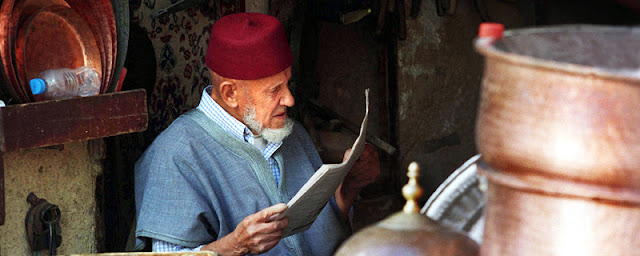The annual Gnaoua Festival drew hundreds of thousands of people to the seaside town of Essaouira this year. Now in its 15th year, the festival is centered on the possession-trance music of the Moroccan Gnaoua and Sufi brotherhoods, as well as music for entertainment. Prominent musicians from around the world also performed and collaborated with local Moroccan musicians, literally filling the city’s streets, stages, ramparts and alleyways with music for four days. For The View from Fez, Philip Murphy and Jesse Poe take a look back on a very successful festival.
The festival began with a musical parade of various Gnaoua and Sufi groups marching, dancing and filling the medina with bands of vibrant color and celebration.
We were fortunate enough to run into our friends and Fez Festival participants, Sheikh Ahmed Marina and the Darqawiyya Sufi order of Essaouira. They proved to be exceptional hosts and guides to Essaouira adding yet another layer of music to the Gnaoua Festival.
 |
| Sheikh Ahmed Marina |
There were large stages set up at Place Moulay Hassan, Borj Bab Marrakech, and on the beach. Different Gnaoua, Sufi, and world music artists performed concerts every night, usually playing independently and then collaborating in world music-Gnaoua/Sufi fusions towards the end of the night. These fusions were interesting in their own ways, though some more successful than others. One particularly successful fusion was that of Indo-Pakistani Qawwali and `Isawa, as each group traded phrases back and forth in their own style, creating a Qawwali/`Isawa call and response well received by the audience.
 |
| Oumou Sangare |
The highlight of the larger concerts was the international star Oumou Sangare from Bamako, Mali. Her band started strong, immediately getting a huge crowd dancing in Place Moulay Hassan. When Oumou came on stage the crowd erupted. Her powerful voice soared and must have been heard all over the city.
In addition to the larger concerts, there were a number of more intimate concerts every night throughout the city. These were the concerts to attend to experience Gnaoua music, providing many opportunities to see the complex ways that this music can straddle the divide between staged performance and possession-trance healing ritual.
 |
| Maalem Mokhtar Guinea |
Maalem Mokhtar Guinea and his large group of Gnaoua who performed at Dar Souiri, encapsulated this dichotomy with grace and powerful intensity. They began with a barrage of percussion and acrobatics, delighting the audience with high jumps and joyful rhythmic dancing. The mood was light and the audience was clapping along. However, after an hour of this, Mokhtar Guinea sat down, began to play his hajhuj (bass lute) and the music gradually became more and more intense. As it did, the mood changed and both musicians and audience members began to experience the music on a different level. Many stood up, clapping and swaying and facial expressions changed from those of joyful spectators to enraptured participants.
 |
| Jidba - the first level of trance |
Mokhtar led his group, and the intimate audience of Dar Souiri, through a series of songs that in time had a number of audience members going into trance. A few women began shaking and swinging their heads up and down, barely held to this planet by those around them.
 |
| Hal - the second level of trance |
Not only women, but also men began to be taken by the music. Towards the end of the concert one large man approached the stage and began to go into trance, contorting his face, shaking, and finally collapsing on the ground.
Music filled the whole city, spilling into the streets and cafes as local musicians took advantage of the festival crowd and staged un-official concerts. These seemed to be everywhere throughout the weekend. We attended an amazing performance by the all women’s group Haddarates d’ Essaouira. Latifa, leader of the group, explained that these women perform healing music and lead retreats that are centered on music therapy. The intense percussion, including frame drums and tea glasses struck against a metal tea tray, with powerful group vocals created a thick texture and beautiful, rhythmic songs that went on for hours.
Each night after the concert stages were cleared, the microphone cables were rolled up and disconnected, and the lights were dimmed, the music refused to be put to bed, carried on the impassioned shoulders of the crowds down the streets and alleyways to cafes, terraces and small plazas where you could find festival musicians joining local musicians, Essaouiraians, travelers and music pilgrims dancing and singing, mixing cultures, traditions, and ages into one sandy wind swept song that sounded like Morocco.
Story and photographs Philip Murphy and Jesse Poe
SHARE THIS!







.jpg)



No comments:
Post a Comment